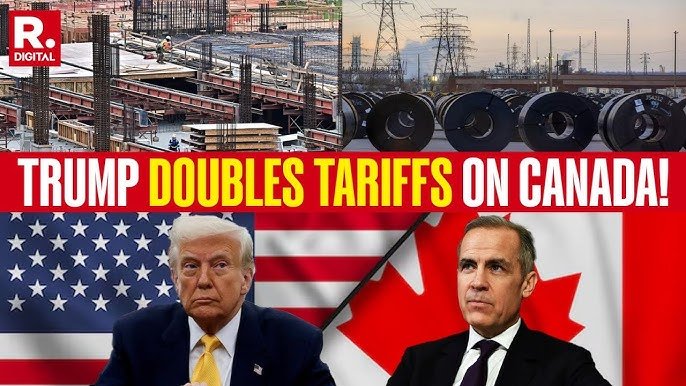In a controversial move that threatens to escalate tensions between Canada and the United States, U.S. President Donald Trump has announced a sharp increase in tariffs on Canadian steel and aluminum imports — doubling the rate from 25% to 50%. The policy, revealed during a press conference at the White House on Tuesday, has sparked immediate backlash from Canadian leaders and reignited fears of a renewed trade war between the two countries.
🔻 A Reversal of Progress
The sudden tariff hike comes just two years after the U.S. and Canada appeared to reach a mutual understanding on industrial metals trade. Trump’s administration claims the increase is meant to “protect American jobs and manufacturing capacity,” particularly in the Midwest, where the steel industry has seen significant layoffs.
“The surge of subsidized Canadian metals continues to flood our markets,” Trump said during the announcement. “This tariff adjustment is necessary to safeguard U.S. economic interests.”
Read full statement on WhiteHouse.gov
Canadian Officials Condemn the Move
Canadian Prime Minister Mark Carney responded swiftly, labeling the tariff increase as “unlawful and unjustified,” emphasizing that it violates existing trade frameworks under USMCA and global trade rules set by the World Trade Organization (WTO).
“This action not only undermines decades of economic partnership,” said Carney, “but it also puts thousands of Canadian and American jobs at risk. We will defend our workers with strength and resolve.”
Read more via CTV News
Ontario Premier Doug Ford echoed this sentiment, calling on Ottawa to double its own retaliatory tariffs on American goods. “We cannot let this stand. Ontario’s manufacturing heartland will not be sacrificed to U.S. election politics,” Ford said during a press event in Toronto.
Full report on Politico
📉 Economic Implications Loom
The steel and aluminum sectors in Canada, concentrated in Ontario and Quebec, employ more than 100,000 people and are tightly integrated with U.S. supply chains. The previous tariff war in 2018–2019 cost the Canadian economy an estimated $2 billion in GDP losses, according to a report from the Fraser Institute.
“This move could have a chilling effect on investment, supply chain reliability, and cross-border trade,” noted economist Rachel Morrison at the University of Toronto. “Given current inflationary pressures and a fragile post-pandemic recovery, this could not come at a worse time.”
🔄 Retaliation Expected
Canada is expected to announce retaliatory tariffs in the coming days. According to trade insiders, likely targets include U.S. agricultural exports, processed foods, and industrial equipment.
“We’re reviewing all options and will respond appropriately to defend our industries,” said Chrystia Freeland, Canada’s Deputy Prime Minister and Minister of Finance.
In 2018, Canada imposed retaliatory tariffs totaling $16.6 billion CAD on American goods in response to similar trade barriers. A similar package is anticipated.
🛠️ Industry Reactions
Steelworkers unions on both sides of the border have issued cautious statements. While U.S. unions have long supported protectionist measures, many are wary of the long-term consequences.
“Short-term gains could be outweighed by long-term instability,” warned the United Steelworkers (USW) union in a joint U.S.-Canada release.
Union statement on usw.ca
Canadian manufacturers, including auto parts and construction companies, are bracing for cost increases and potential delays in delivery timelines.
🌐 Global Ramifications
The new tariffs could also strain U.S. relations with other global trading partners, as the World Trade Organization (WTO) has previously ruled against similar protectionist measures by the Trump administration.
“The international community is watching,” said WTO spokesperson Elena Martín. “We urge both parties to resolve disputes through lawful means and mutual negotiation.”
✍️ Final Thoughts
As Canada and the U.S. navigate this renewed economic conflict, the stakes are high for both economies. With elections approaching in both countries, leaders appear poised to prioritize political narratives over long-term trade stability — a gamble that may have serious repercussions for businesses and consumers alike.

